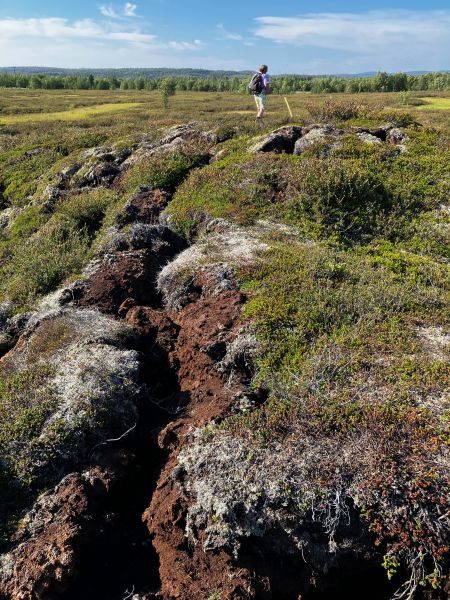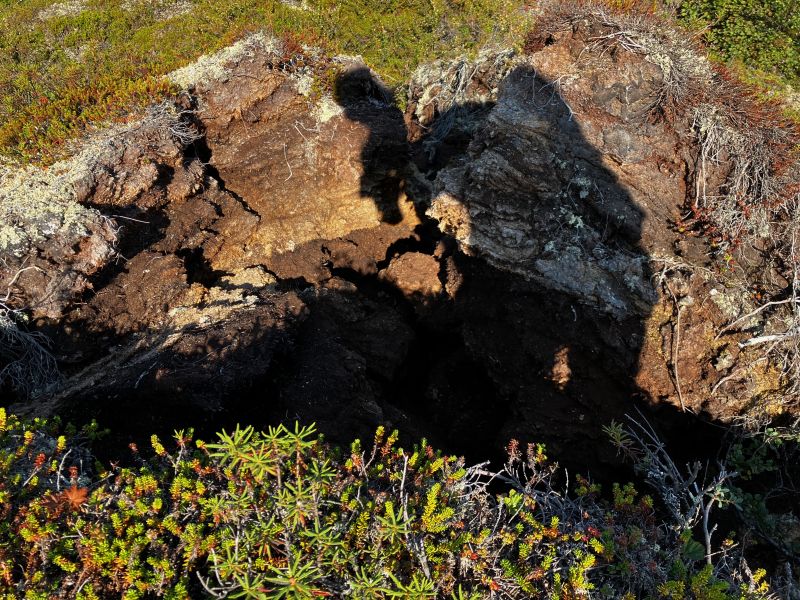The Choreography of the Bucket Mire
A wasp whizzes around the fragrant Finnmarkspors, wild rosemary (Rhododendron tomentosum). It is mid-August and few of the plants are flowering – here and there a late cloudberry plant is in bloom, although most of the berries are already overripe or gone. The mood, nonetheless, is one of exuberant life, an intense vitality.
We are moving from the edge of the road near the Finnish border towards some tantalizing bumps in the landscape. These are palsas, peat mounds formed by sporadic permafrost. They are a way that the earth itself visibly overturns the landscape, several meters of ice underneath laying the soil on top of the surface. An endangered ecosystem, palsa mires have declined in Northern Scandinavia for decades and are likely to disappear from these areas in a few years’ time. They give this small, random bog which most people drive by a certain status, a special value.
Who belongs here?
This mire is rarely frequented by humans. Most mires are heavily visited in the cloudberry season, and one might imagine that the name of this place, Bøttemyra ('Bucket mire'), is a reference to buckets of berries, but it might be too small, and is outcompeted by the much larger, nearby Ferdesmyra (Travellers’ Mire). A reindeer herder has a fence nearby and passes through with his flock.
The summer air hums. The scents of the mire are overwhelmingly sharp, teasing the nose with fresh and spicy notes. Our bare feet encounter sharp bush twigs and needles when we try to move on the dry top of the mire, teetering between pain and massage. And it is dry indeed. The sun has shone relentlessly, no rain in sight, for many weeks. Bodies seek the softness of the wet moss in the lower parts of the terrain, with the risk of sinking in. Nowhere we walk do we encounter that telltale smell of farts, that would indicate an anaerobic bog. This wetland is fresh.
The two of us walk comfortably, often going our separate ways, then meeting again, weaving our way through a conversation broken by our need to navigate the volumes of undulating and flat substrates. The choreography of the mire moves us, more than we move ourselves. When we finally sit down together, on one of the little peat-arms of the ‘great palsa’, the coolness of its perma-frost connects with the tailbone.
- Nora S. Vaage & Hilde Methi, 9th of August, 2024
Coming to the mire: An Invitation
How does the mire move you? How does it choreograph other organisms? Take the time to think, talk with your companions and pay attention to the various life forms. Think about the ‘ankomst’ (coming to) the mire. What draws your attention? Do you perceive the palsas? When do you perceive them? From what angle? Why? Take your time. Try walking barefoot. Notice your environment. You will have to move around in some spots if you do not want to get wet or sink. This is part of the choreography of the mire. You seek to move according to this choreography, minimize the disturbance to the life forms. Notice where it does and does not invite you to step. Can you feel its cleansing properties? Smell the mire with your feet.
On the 15th of August, 2024, we took a group of 30 researchers and artists to visit the Bucket Mire. We gave them the above invitation.
A small army invades the mire, playfully, with great appreciation for its wondrous vibrancy, and perhaps too little understanding of the vulnerability of its unusually dry state. What makes it easier, more pleasant for us to move through the mire also makes our entry more of a strain on the system.
Two knowledgeable colleagues refrain from entering, and watch with a sense of dread as the rest of us play in it. This becomes the topic of a conversation the following day, at a former Skolt Sami winter village in one of the forests of Pasvik.
When is it ok for us to enter?
How do we know whether a place welcomes us?
What number of humans is too many for a place to bear, when trying to minimize our mark upon it?
The Skolt Sami had the same winter village for a number of years, and moved when they had depleted the firewood resources of a place. This means the only visible trace, a few decades later, is the stone ovens they left behind.
In the Bucket Mire one of our number found an old glove, one a dog’s collar, another a plastic bag. A few plastic tubes were stuck into the palsa, probably for scientific reasons. It is not a pristine ecosystem, but it is worthy of protection. Do we stay out of it? What is the choreography of absence? Should there be signs when the mire is too dry to absorb us? Can we make such signs?
There were messages (stories? answers?) in the touch of Finnmarkspors, other Bircheris and lichen against our feet, in the ways we were carried forward or sank into soft moss. We could not quite grasp them.

